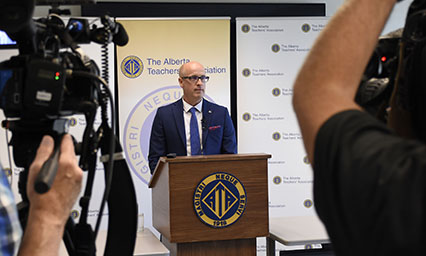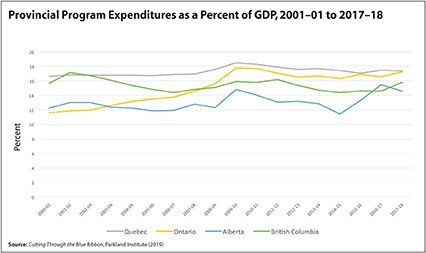Page Content
 “Education relies on stability.” That was how ATA president Jason Schilling began his response to recommendations of the Alberta Government’s Blue Ribbon Panel on Alberta’s Finances, which was released in early September.
“Education relies on stability.” That was how ATA president Jason Schilling began his response to recommendations of the Alberta Government’s Blue Ribbon Panel on Alberta’s Finances, which was released in early September.
“But, if the government chooses to follow the recommendations of the MacKinnon report, it will turn uncertainty into instability across the sector,” he added.
The Alberta government chose the first day of school to release the recommendations and report of the Blue Ribbon Panel on Alberta’s Finances. The panel, chaired by former Saskatchewan Finance Minister Janice MacKinnon, was assembled to “conduct a ‘deep dive’ into Alberta’s fiscal situation, recommend a path to balance, and propose a realistic plan to start paying down the debt.”
Notably, the panel was directed to look at plans to balance the budget by 2022-23, “without raising taxes.” It proposes a path to balance that is achieved through
$600 million in spending cuts over the next four years, with a corresponding $7.5 billion increase to government revenues, largely achieved through economic expansion and increased resource revenues.
Many critics highlighted this one-sided look at Alberta’s finances as a serious flaw with the panel’s mandate.The Parkland Institute released an alternative blue ribbon report on Sept. 9.
“While there are almost certainly savings to be found on the expenditure side, Albertans simply can’t keep pretending the revenue side doesn’t exist.” stated co-author Bob Ascah, former director of the University of Alberta’s Institute for Public Economics.
Schilling agrees with the criticism on revenue myopia, but he is more critical of what the report recommends for K–12 education.
“This report undermines confidence in the public education system, even though it is clear in the report that education is not the problem,” said Schilling. “There is no crisis that needs to be solved when it comes to K–12.”

ATA president Jason Schilling voices his concerns about the Alberta Government’s
Blue Ribbon Panel on finances during a news conference on Sept. 3.

The following is an overview of the report’s references to education and the association’s response.
What the MacKinnon Report says:
|
The Association response:
|
|
On general government spending:
|
|
“Albertans should be especially concerned about the fact that the province is spending more per capita than the three other large provinces on most of its programs and services but often getting poorer results. Raising taxes to find more money for the current level of programs and services is not the answer.” (p. 9)
“Cuts around the edges won’t get Alberta back to a sustainable balanced budget. The government needs to make a difficult but necessary fiscal course correction immediately to return the province to fiscal health over the medium to long term.” (p. 12)
“For example, if the government had frozen spending at $53.1 billion in 2016/17, the budget deficit would have been $3.2 billion lower than it was in 2018/19.” (p. 20)
|
• From Cutting Through the Blue Ribbon: A Balanced Look at Alberta’s Finances, Parkland Institute, 2019:
- The above graph summarizes the position of Alberta vis-à-vis the three largest provinces in terms of the relative size of program expenditures compared to the size of the provincial economy for the fiscal years 2000–01 to 2017–18. For almost of all this period, Alberta has had the lowest relative program expenditures. (p. 23, Figure 12).
• Alberta is by all objective measures the lowest taxed province in Canada; the deficit would be eliminated tomorrow if Alberta adopted the taxation regime of BC, the next lowest taxed province in the country.
• The MacKinnon report suggests $600 million in spending cuts over the next four years and the finance minister has suggested in news reports that even deeper cuts will be needed.
• The scale of cuts projected would have a stark and noticeable impact on student learning conditions.
• Alberta has experienced rapid student population growth over the last decade: 16.7% from 2007–08 to 2016–17. A funding freeze would have left schools with no additional funding in the face of thousands of new students each year.
|
|
On education funding:
|
|
“Alberta spends $11,121 per student. British Columbia spends
$9,681 per student, the lowest among our comparator group, while Ontario spends $17,077 and Quebec spends $12,325 per student.” (p. 34)
“From the Panel’s review, the total amount of funding government spends on education is not out of line with comparable provinces.” (p. 38)
|
• The panel report is clear: K–12 education is not the problem. Our per-pupil program spending is well below the other provinces, with the exception of BC.
• Alberta funds a separate Catholic school system, as well it should given the constitutional rights that exist in Alberta, and the Association supports Catholic education. BC does not fund public Catholic education, and funding two parallel public education systems comes with some duplication of services.
• Alberta has fully funded charter schools, which BC does not, and provides greater funding for private schools than BC does. Despite this increased funding, a greater proportion of students attend private school in BC than in Alberta. Savings can be made by reducing the amount of public funding provided to private schools. |
|
On education outcomes:
|
|
“There are significant differences in school board performance across the province. Alberta Education uses 16 measures that make up their accountability structure. As Figure 12 indicates, the level of spending by a school board is not the key factor that drives better outcomes.” (p. 36)
“Funding formulas based purely on numbers of students as opposed to the outcomes achieved have a number of shortcomings. Perhaps the most significant drawback of enrolment-based funding is that it incents competition between boards at the expense of collaboration in key areas where greater efficiencies could be achieved.” (p. 37)
|
• The KPMG report that was released in association with the panel’s recommendations highlights that the bulk of school boards are achieving “high” or “very high” results on more than 80% of their achievement measures. Outcomes in education in Alberta are generally very good.
• However, KPMG’s analysis of board performance does not take into account problems that some boards face with poverty and other social factors.
• Alberta’s education system has been successful largely because features within it are based on collaborative approaches instead of competitive approaches.
• We support the notion that school boards would be encouraged to collaborate further on educational enhancements and system efficiency, but are cautious about the ability to achieve these efficiencies through reduced funding, without affecting the classroom. |
|
On administration and governance spending:
|
|
“Recommendation 5: The Panel recommends that government work with education stakeholders to decrease the percentage of government funding that goes to administration and governance (currently 24.6%) to a level comparable to British columbia (17%).” (p. 38)
“A review of Alberta Education expenditures indicates that 75.4 cents of every dollar spent on education is used to deliver K–12 programming while 24.6 cents is spent on supporting and administering the operations of school boards and the system. By comparison, British Columbia spends 83 cents, Ontario spends 73 cents and Quebec (K-11) spends 76 cents to deliver programs to students.” (p. 34)
|
• The 24.6% figure includes spending on plant operations and maintenance, transportation, board and administration expenses as well as external services.
• According to the Alberta School Boards’Association (ASBA), actual spending on school administration and board governance is lower in Alberta (3%) than in BC (3.9%)
• ASBA also states that school transportation is not mandated in BC, with some students living as far as 4.8 km from their school being left unfunded for transportation.
• Transportation and Plant Operations and Maintenance (POM) funding is often not sufficient to cover actual costs incurred by school boards, and where shortfalls exist, boards have to take money out of the classroom:
- In 2016/17, the shortfall in funding for POM was $79 million.
- In 2016/17, the shortfall in funding for Transportation was $23 million.
• Governments in the past have tried to reduce central office spending, and every time it has resulted in less funding for schools, larger classes and fewer supports for students with special needs.
• Alberta has the largest and most expensive provincial testing regime in the country. We can reduce administrative spending by starting there. |
|
On performance-based funding:
|
| “Recommendation 6: The Panel recommends that government completely review and revise its current education funding formula to ensure enrolment growth is addressed and to provide incentives for sharing services and achieving better outcomes for students.” (p. 38) |
• Funding based on performance would be disastrous.
• This is the No Child Left Behind idea that has plagued America’s education system. We don’t need to steal bad ideas in education from the United States.
• Performance-based funding means giving more money to students and schools that are already doing well. Which means that the students and schools that need the most support, get the least.
• Incentivizing performance within a model of school choice gives incentives to schools to turn away the neediest students. (See Editorial on page 2.) |
|
On teacher salaries:
|
|
“The Panel found that the maximum teacher salaries in Alberta are comparable to those in Ontario but higher than those in British Columbia. (See page 50 for comparisons of teachers’ salaries and benefits.)” (p. 35)
“Alberta teacher salary levels are higher than in British Columbia but lower than in Ontario; however, Alberta teachers have other special benefits and, when these are included, their compensation is the highest across the comparator provinces.” (p. 46)
“The Panel found that Alberta’s bargaining is often out of sync with other provinces. Public sector bargaining in Alberta has been focused on comparing compensation of public sector employees to compensation paid in the private sector. A more appropriate comparison would be to look at what public sector employees, including nurses, doctors, teachers and government employees, are paid in other provinces.” (p. 49)
|
• Teachers have already experienced significant salary restraint: six zeroes in seven years.
• The panel report includes the government’s assumption of the pre-1992 Teachers Pension Plan liability as part of teacher compensation; it is not. The liability was the government’s responsibility because successive governments did not contribute sufficiently to the plan, even as teachers voluntarily increased their contribution. The cost of the government cleaning up its mess and previous obligations should not be counted as part of teachers’ compensation today. Alberta teachers are actually paid less than teachers in Ontario even though wages in Alberta are generally higher than they are in Ontario.
• Teachers are part of the Alberta labour market. Wages in Alberta are generally about 15% higher than in British Colombia, whereas teacher salaries in Alberta are only about 11% higher than in BC.
• An education degree is highly portable, both geographically and also across industries. Skills that teachers possess are sought after by many employers in private industry, so teachers must be compensated appropriately, relative to their education level, for the labour market they are participating in. |
|
On legislated bargaining mandates:
|
|
“Recommendation 10: The Panel recommends that the government should establish a labour relations framework that creates long-term goals for compensation in line with other comparable provinces.” (p. 50)
“Recommendation 12: The Panel recommends that the government establish a legislative mandate that sets the salary levels for all public sector employees, including all fees and other compensation for insured medical and health services and all third parties, and applies to all negotiations and arbitrations. In the event of a strike, the mandate would form the basis for back to work legislation.” (p. 50)
|
• Teachers have already experienced significant salary restraint: six zeroes in seven years.
• Using aggressive and draconian legislation in place of fair negotiation would create an adversarial relationship with teachers and poison the culture that schools currently enjoy.
• Using legislation to impose on collective bargaining would destabilize schools and the teaching profession.
• Courts, including the Supreme Court of Canada, have ruled that Canadians’ right to freedom of association covers their right to union membership and fair collective bargaining but also extends to the outcomes of that bargaining – the provisions contained in collective agreements.
• We would fight legislation with every legal means – and we will win in the courts. The government would be picking a very long and very expensive fight with teachers and other public sector workers. |
|
On fixed budget dates:
|
| “Recommendation 25: The Panel recommends that Alberta establish a fixed budget date.” (p. 72) |
• The Association would support this recommendation.Too often school boards are left with insufficient information that do not allow them to properly plan for schools in September.
• With funding uncertainty and limited information, it is often classrooms that get pinched. |
